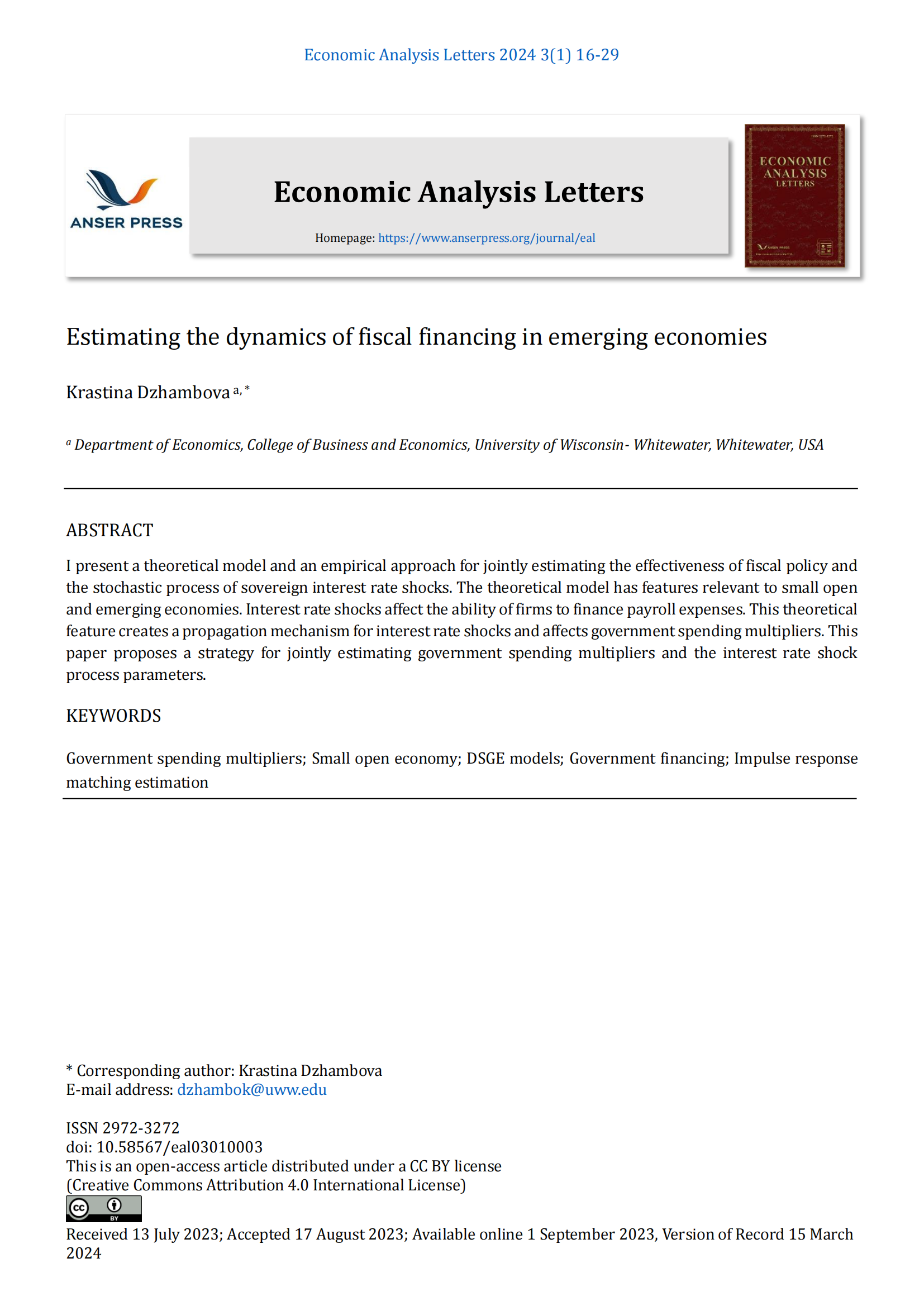Estimating the dynamics of fiscal financing in emerging economies
DOI:
https://doi.org/10.58567/eal03010003Keywords:
Government spending multipliers; Small open economy; DSGE models; Government financing; Impulse response matching estimationAbstract
I present a theoretical model and an empirical approach for jointly estimating the effectiveness of fiscal policy and the stochastic process of sovereign interest rate shocks. The theoretical model has features relevant to small open and emerging economies. Interest rate shocks affect the ability of firms to finance payroll expenses. This theoretical feature creates a propagation mechanism for interest rate shocks and affects government spending multipliers. This paper proposes a strategy for jointly estimating government spending multipliers and the interest rate shock process parameters.
References
Abel, A. (1990). Asset Prices Under Habit Formation and Catching up with the Jones. American Economic Review 80, 38-42. https://www.jstor.org/stable/2006539
Akinci, O. (2013). Global Financial Conditions, Country Spreads and Macroeconomic Fluctuations in Emerging Countries. Journal of International Economics 91, 358-371. https://doi.org/10.1016/j.jinteco.2013.07.005
Arteta, C., and Hale, G. (2008). Sovereign Debt Crises and Credit to the Private Sector. Journal of International Economics 74, 53-69. https://doi.org/10.1016/j.jinteco.2007.05.008
Barrail Halley, Z. (2017). Expansion of the Middle Class, Consumer Credit Markets and Volatility in Emerging Economies. PhD thesis, Boston College. http://hdl.handle.net/2345/bc-ir:107373
Bilbiie, F., Ghironi, F., and Melitz, M. (2012). Endogenous Entry, Product Variety, and Business Cycles. Journal of Political Economy 120, 304-345. https://doi.org/10.1086/665825
Christoffel, K., Jaccard, I., and Kilponen, J. (2011). Government Bond Risk Premia and the Cyclicality of Fiscal Policy. ECB Working Paper No. 1411. http://dx.doi.org/10.2139/ssrn.1969854
Coleman, W. J. II. (2000). Welfare and Optimum Dynamic Taxation of Consumption and Income. Journal of Public Economics 76, 1-39. https://doi.org/10.1016/S0047-2727(99)00043-2
Dzhambova, K. (2021). When It Rains, It Pours: Fiscal Policy, Credit Constraints and Business Cycles in Emerging and Developed Economies. Journal of Macroeconomics 69, 103319. https://doi.org/10.1016/j.jmacro.2021.103319
Gali, J., Lopez-Salido, and Valles, J. (2007). Understanding the Effects of Government Spending on Consumption. Journal of European Economics 5, 227-270. https://doi.org/10.1162/JEEA.2007.5.1.227
Garcia, C., and Restrepo, J. (2007). How Effective Is Government Spending in a Small Open Economy with Distortionary Taxes. Central Bank of Chile. http://fen.uahurtado.cl/wp-content/uploads/2010/07/inv188.pdf
Garcia-Cicco, J., and Kawamura, E. (2015). Dealing with the Dutch Disease: Fiscal Rules and Macro-Prudential Policies. Journal of International Money and Finance 55, 205-239. https://doi.org/10.1016/j.jimonfin.2015.02.009
Gertler, M., Gilchrist, S., and Natalucci, F. (2007). External Constraints on Monetary Policy and Financial Accelerator. Journal of Money, Credit and Banking 39, 295-330. https://doi.org/10.1111/j.0022-2879.2007.00027.x
Hall, R. (2009). By How Much Does GDP Rise If the Government Buys More Output? Edited by Romer, D. and Wolfers, J. Brookings Papers on Economic Activity. http://www.nber.org/papers/w15496Hevia, C. (2014). Emerging Market Fluctuations: What Makes the Difference? Journal of International Economics 94, 33-49. https://doi.org/10.1016/j.jinteco.2014.05.002
Lama, R., and Medina, J. P. (2012). Is Exchange Rate Stabilization an Appropriate Cure for the Dutch Disease. The International Journal of Central Banking 8, 143-189. https://www.ijcb.org/journal/ijcb12q1a1.htm
Leeper, E., Plante, M., and Traum, N. (2010). Dynamics of Fiscal Financing in the United States. Journal of Econometrics 156, 304-321. https://doi.org/10.1016/j.jeconom.2009.11.001
Magud, N., and Sosa, S. (2010). When and Why about Real Exchange Rate Appreciation? The Missing Link Between Dutch Disease and Growth. Journal of International Commerce, Economics and Policy 4, 1350009. https://doi.org/10.1142/S1793993313500099
Mandelman, F. S. (2013). Monetary and Exchange Rate Policy Under Remittance Fluctuations. Journal of Development Economics 102, 128-147. https://doi.org/10.1016/j.jdeveco.2012.02.006
Neumeyer, P., and Perri, F. (2005). Business Cycles in Emerging Economies: The Role of Interest Rates. Journal of Monetary Economics 52, 345-380. https://doi.org/10.1016/j.jmoneco.2004.04.011
Reinhart, C., Rogoff, K., and Savastano, M. (2003). Debt Intolerance. Brookings Papers on Economics Activity. https://www.brookings.edu/articles/debt-intolerance/
Schmitt-Grohe, S., and Uribe, M. (2003a). Anticipated Ramsey Reforms and the Uniform Taxation Principle: The Role of International Financial Markets. NBER. https://doi.org/10.3386/w9862
Schmitt-Grohé, S., and Uribe, M. (2003b). Closing small open economy models. Journal of International Economics 61, 163-185. https://doi.org/10.1016/S0022-1996(02)00056-9
Uribe, M., and Yue, V. (2006). Country Spreads and Emerging Economies. Journal of International Economics 69, 6-36. https://doi.org/10.1016/j.jinteco.2005.04.003

Downloads
Published
How to Cite
Issue
Section
License
Copyright (c) 2023 Krastina Dzhambova

This work is licensed under a Creative Commons Attribution 4.0 International License.